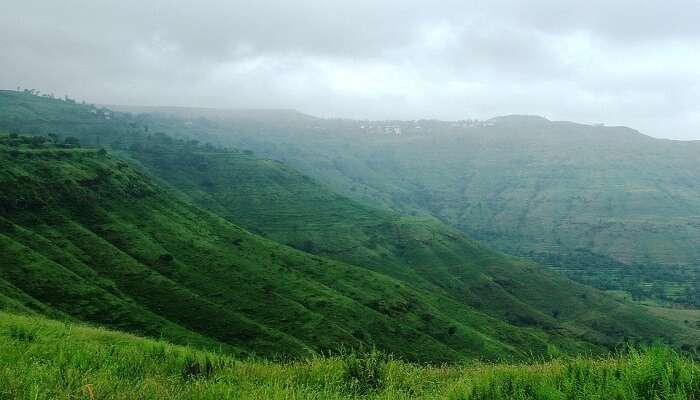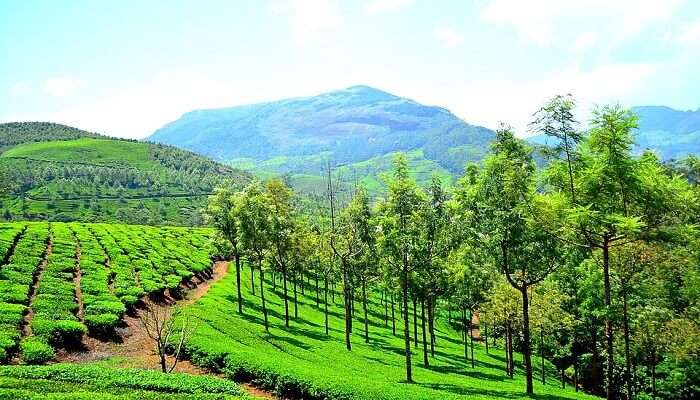Complete Guide To Visit The Kanheri Caves In Mumbai In 2025
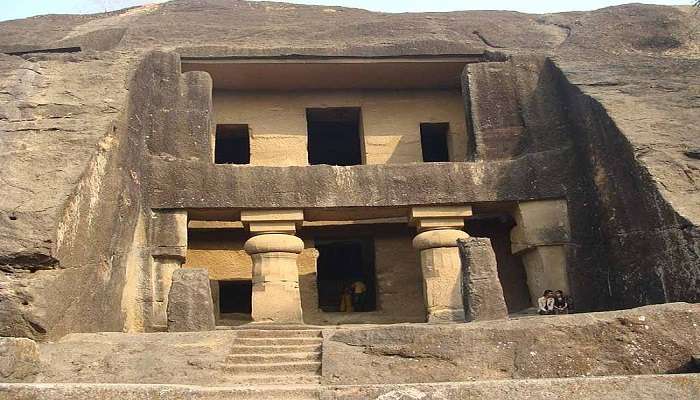
Kanheri Caves in Mumbai, located within the greens of the Sanjay Gandhi National Park in the middle of Mumbai, aggressively speak about Indian history. These ancient rock-cut caves are said to have existed since the 1st century BCE and used to be a Buddhist monastic complex where the monks provided learning and spiritual enlightenment to the people. Located deep into the basalt rocks, the Kanheri Caves exhibit some of the finest sculptors, inscriptions, and architectural marvels that speak volumes of the artistic abilities of the artisans of the place.
Places To Visit In Kanheri Caves In Mumbai
Apart from the captivating and historical Kanheri Caves, this area of Mumbai offers scores of other natural and cultural sightseeing opportunities for travellers. The Sanjay Gandhi National Park, or the Kanheri Caves, is a large stretch of green scenery and wildlife where one can engage in hiking, bird watching, and wildlife tours.
1. Main Chaitya Hall
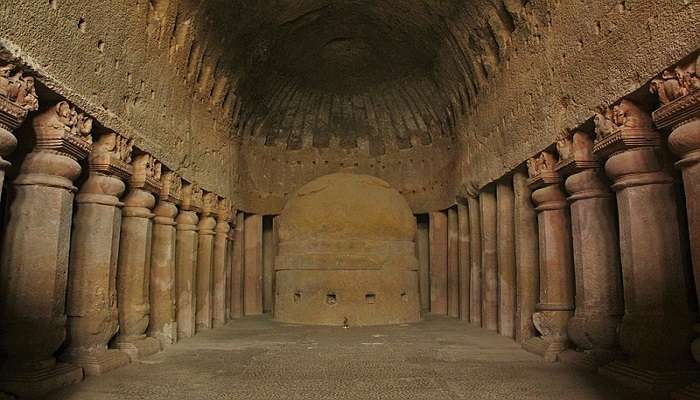
In size, the Main Chaitya Hall is the most extensive and detailed of the Kanheri Caves, and it fulfils the role of the focal structure of the ancient Buddhist monastic complex. This is a large prayer hall carved out of the rock – it’s monumental with a sixty feet high stupa at the far end of the hall.
A stupa, which is a hemispherical structure symbolizing the Buddha, is in the middle of the hall and surrounded on all four sides by bold carvings and sculptures on the walls of the large hall. The hall’s ceiling is carved directly on the basalt rock, and its high altitude makes the hall as magnificent and sacred as it sounds. On the side of the hall, there are long rows of benches carved in stone, and this seems more or less to indicate that this was the prayer /meditation chamber for the Buddhist monks who once occupied the premises.
Location: Sanjay Gandhi National Park Borivali, Mumbai, Maharashtra.
Timings: 7:00 am to 5:30 pm
Also Read: Picnic Apots In Mumbai
2. Vihara Caves

The Vihara caves of the Kanheri Caves complex, dating from the 1st century BCE to the 2nd century CE, give testimony to the extraordinary quality of monastic architecture and art from the Buddhist community of the region. Hewn out of rock and originally used as dwellings for the Buddhist monks, these residential caves are reinforced with delicate Spencer works and sculptures.
Every Vihara Cave is beautifully and professionally hewn out of basalt rock, and the way they have done it leaves one with no doubt that the people who created these caves were engineers. The Stupa structure located in the interiors of the Vihara Caves successfully contains well-ornamented doors and windows along with ceilings containing motifs and patterns evident from the Buddhist art period.
Location: Sanjay Gandhi National Park Borivali, Mumbai, Maharashtra.
Timings: 7:00 AM to 5:30 PM
3. Inscriptions
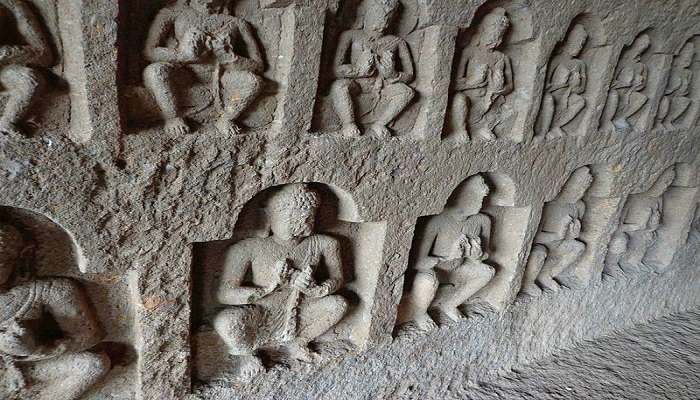
The Kanheri Caves complex contains a rich set of historical writings that are positively absorbing and enlightening for those interested in revealing history about the site’s physical and ontological modes of existence as a centre for the monastic activities of Buddhists. These inscriptions are found in different caves and rock-cut architectures where the present-day archaeologists and people get exposure to this historical archaeological site’s once intellectual and spiritual culturally hectare place.
Inscriptions found at Kanheri are mostly in Brahmi script, one of the widely used scripts in ancient India. They contain information ranging from simple dedication texts used to celebrate the construction or dedication of specific cave constructive parts to more complex historical texts reporting monastic activities, their sponsors, and relations with the outside world.
Location: Sanjay Gandhi National Park Borivali, Mumbai, Maharashtra.
Timings: 7:00 AM to 5:30 PM
Related Post: Resorts Near Mumbai In Budget
4. Sculpture Gallery
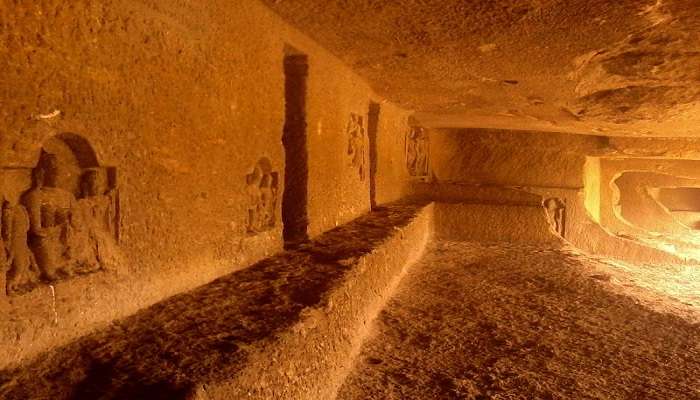
The sculptures executed on the basalt rock portray the excellent workmanship of the people inhabiting the caves and their attention to the fine details. The Buddhas are sculpted in a way that is most appealing to the eye, and each of the sculptures brings out the teacher’s meditation and peaceful demeanour. Buddha’s ear lobes and face are well-modelled, and the typical mudras and hand gestures are well-sculpted.
There are also many other statues in the Sculpture Gallery, such as the Bodhisattva Statues of Avalokiteshvara, which represents compassion, and Manjushri, which symbolizes wisdom. These sculptures are carved very delicately, and the figures depict beautiful movements and signify the artistic and spiritual spirit of Kanheri monks.
Location: Sanjay Gandhi National Park Borivali, Mumbai, Maharashtra.
Timings: 7:00 AM to 5:30 PM
5. Waterfall Cave
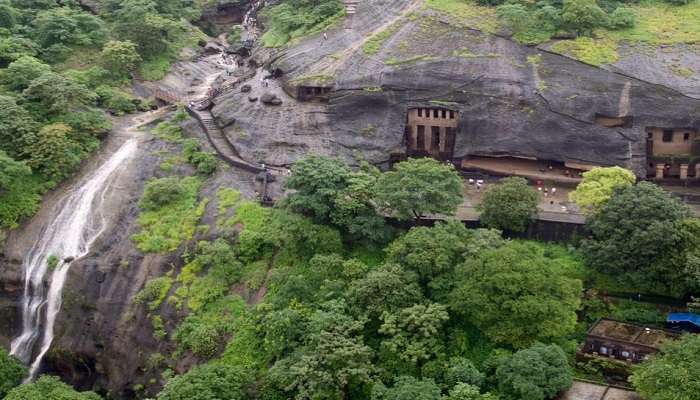
There’s possibly no better attraction to combine with the sight of the Kanheri Caves than the one naturally formed waterfall – the Waterfall Cave. Sophisticated as the architectural accomplishment, this unique rock-cut cave seems to blend nature’s conceived environment and complement man’s programmed environment, as seen in numerous cave paintings across the globe.
On the way to the Waterfall Cave, the water echo leads one’s sight upward, where a naturally formed waterfall pours into a basin. The water source is a freshwater stream collected from a cave well situated at a higher altitude than the cave opening; the water’s fall rattles constantly and forms a natural ladder, which adapts the entire cave to a relatively serene atmosphere.
Location: Sanjay Gandhi National Park Borivali, Mumbai, Maharashtra.
Timings: 7:00 AM to 5:30 PM
You May Also Like To Read: Mumbai To Bangalore Road Trip
The star attraction near Mumbai is the Kanheri Caves, which exhibit a blend of geographical and historical significance. Spanning the Main Chaitya Hall, the Vihara Caves, and the Waterfall Cave, this tremendous historic landmark is one place families should not miss when they go out on historical holidays. Plan Your trip to Mumbai with your family today. Visit the Kanheri Caves. What you and your families are set to experience will build within you and within your families as well a more profound sense of pride for what India has to offer to the rest of the world.
For our editorial codes of conduct and copyright disclaimer, please click here.
Cover Image Credit: Sreejithsh for Wikimedia Commons
Frequently Asked Questions About Kanheri Caves In Mumbai
How long should I plan to spend at the Kanheri Caves?
The main sites for visiting Kanheri Caves that will at least take 2-3 hours to explore are; Plan your time properly when visiting Kanheri Caves so that you can get the best feelings of the dumped calmness of the place and explore the main attractions adequately.
What are the must-see attractions at the Kanheri Caves?
The features of interest are the Main Chaitya Hall, the decorated subsidiary caves known as Vihara Caves, the waterfall cave, and the various inscriptions that go around the complex to tell history.
Is the Kanheri Caves complex suitable for families with children?
Indeed, the Kanheri Caves complex is perfect for children; families can visit it. Here, there are a lot of genuinely historical and natural objects that create an incredible interest for both adults and children. A family-friendly area is the Waterfall Cave. Most of the families come here to spend a couple of hours walking and enjoying the beautiful views of nature.
Are there any facilities or amenities available at the Kanheri Caves?
In terms of the facilities available, establishments as simple as restrooms and drinking water are provided at the Kanheri Caves. Present near the entrance. There are also a few small shops and cafes; however, if you plan to walk a long time in the park, it is better to stock up on food and water.
How can I get to the Kanheri Caves from Mumbai?
The Kanheri Caves are also one of the cave complexes located in the Sanjay Gandhi National Park on the outskirts of Mumbai i.e. 30 Km from Mumbai city. One has to come to Borivali station by a local train and then one can either get into a bus or hire a taxi or an auto-rickshaw to get to the caves.
People Also Read:
Khambhalida Caves Arwah Caves Alfred Caves

With a passion for exploring and travelling to the roads long forgotten, experience the world through enthralling stories and adventures. Join me as I share my experiences at some of the world’s most popular tourist destinations and quench that pestering curiosity with something exciting!



